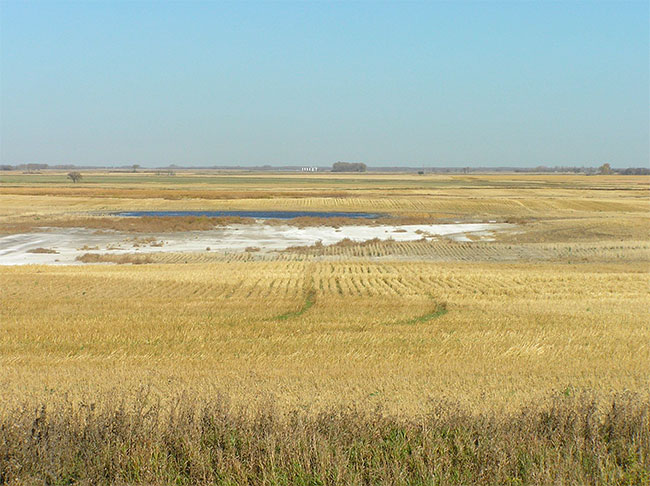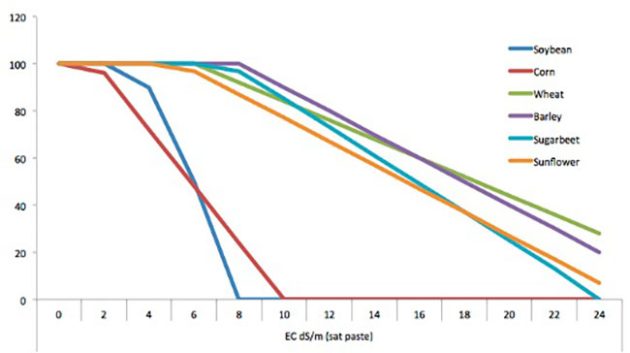
Features
Environment
The side effects of wet/dry cycles
Dealing with salinity after a drought.
June 20, 2022 By Presented by Marla Riekman, soil management specialist with Manitoba Agriculture, at the Top Crop Summit, Feb. 23, 2022.
 ABOVE: There are no quick fixes to salinity. Photo courtesy of Manitoba Agriculture.
ABOVE: There are no quick fixes to salinity. Photo courtesy of Manitoba Agriculture. Salinity problems always follow wet dry cycles. It isn’t like salinity is here and then gone – it ebbs and flows. Salinity isn’t a salt problem. It is a water problem. If trying to manage salinity, water flow in the soil needs to be managed, and that is impacted by the level of the water table.
Several conditions are required to create a soil salinity problem. The first is a high water table that carries soluble salts into the root zone by capillary action. For this to occur, the water table needs to be less than six feet from the surface. Capillary rise can easily occur in clay soils, and less in sandy soils. The second is that evaporation exceeds infiltration for significant periods of time.
Pulses, vegetables and oilseeds are more susceptible to soil salinity. Crops like soybean and corn are very susceptible to salinity.
Salinity effects on crops
Salinity can occur in a variety of ways. Bathtub ring salinity is common in pothole country. Water in a slough moves downward in the soil, picking up salts that are moved upwards around the edges of the slough. This results in salinity in a circular pattern around the slough. Roadside salinity is similar where water in the ditch moves salts into the rooting zone along the headlands.
Electrical Conductivity (EC) is a measure of soluble salts in the soil. As the concentration of soluble salts increases, the EC of the soil extract increases. EC is expressed in dS/m, mS/cm, or mmho/cm, and these units are all equal.

Graph courtesy of NDSU.
There are several methods to diagnose the severity of soil salinity. Soil samples from zero- to six-inch and six- to 24-inch depths can be used for analysis. But there are two types of analysis used in the lab. Research and soil survey labs use the saturated paste method with a 1:2 soil:water ratio. Commercial soil test labs use a 1:1 soil:water ratio because it is faster and cheaper. As a result, to compare research results to commercial results, multiply the 1:1 commercial results by two to get the same approximate EC values from research and soil survey results, or divide research results by two to get the equivalent commercial lab result. Soils can also be mapped using EM 38 or Veris Soil EC 3100. These are electromagnetic induction (EMI) devices that create a magnetic field to measure salinity. For both, calibration with soil tests is critical, as EC can change with clay and moisture content.
We deal with and manage salinity, but we can’t fix it. Use yield maps to determine where the poor growing saline areas are in a field – and then, stop wasting money on them. Invest in the saline spots by soil sampling to see how bad the salinity is, and look at putting some crop on them to manage the water. Plant a saline-tolerant crop that can lower the water table, or possibly use tile drainage. Keep the soil covered and reduce tillage to reduce evaporation that exceeds moisture infiltration.
Make strategic choices to manage water. Use high water use crops in non-saline areas, and use weeds to your advantage in saline areas. Plant a buffer crop to take up water along headlands or to
intercept water around sloughs. For example, plant willows around sloughs to use water before it moves salts into the rooting zone, or plant alfalfa along the headlands to intercept water with roadside salinity. A longer-term solution can be the installation of tile drainage. This has potential but it is a slow process. Research in Manitoba found that it took about 10 years to reduce EC by one point.
Another approach may be to keep soils covered by placing mulch or manure or straw over the saline patches to decrease evaporation. But this may only be feasible on small areas and may not be the most effective solution. If you do nothing else, then do nothing at all. Resist the urge to till saline soils. Tillage encourages evaporation from the soil surface and brings more salts up via capillary rise.
For more severely saline soils, forages may be the only option. There are some very tolerant varieties, and AC Saltlander green wheatgrass is one of the better options showing good tolerance to highly saline soils.
The important thing to remember is that you should be skeptical of “quick fixes.” Ignore chemicals, commercial soil conditioners and other quick fixes. Remember, it’s not a salt problem but a water problem. The long term benefit of managing for salinity can pay off in the future, but patience is needed.
Watch the presentation here:
www.youtube.com/watch?v=A3s4QxxQfZg